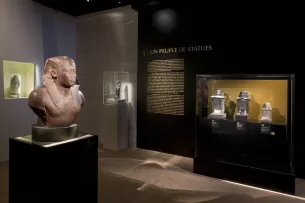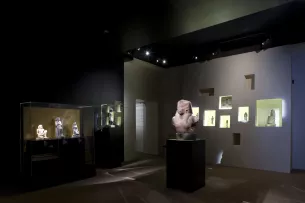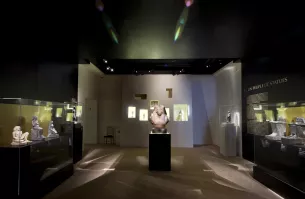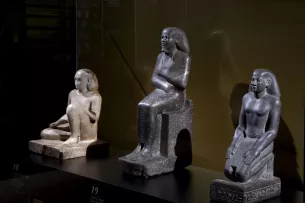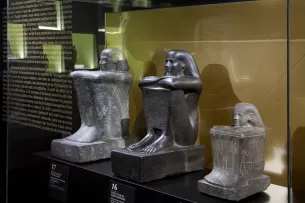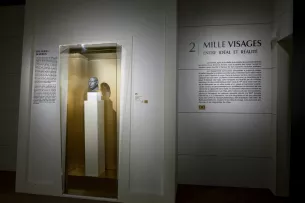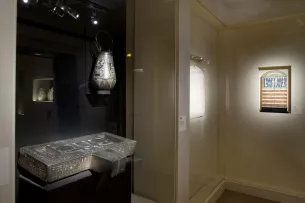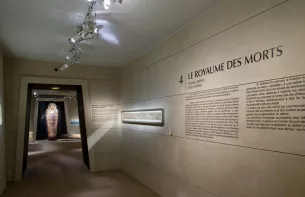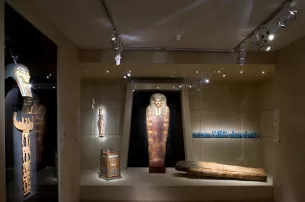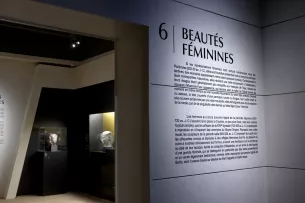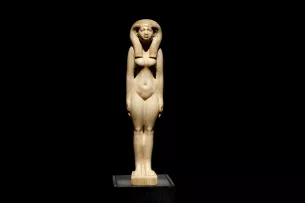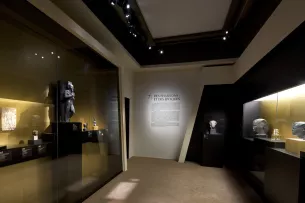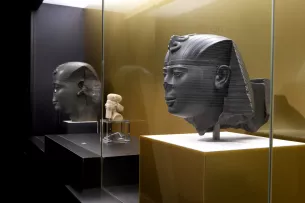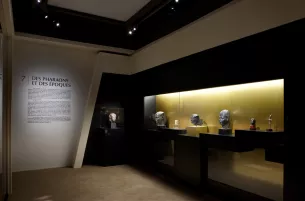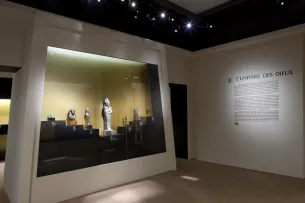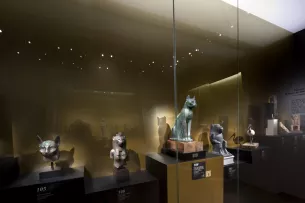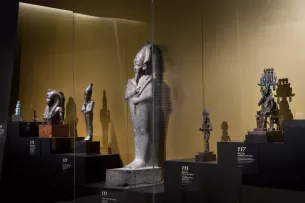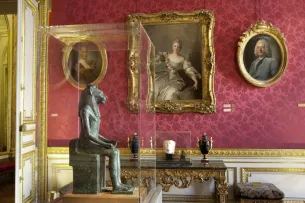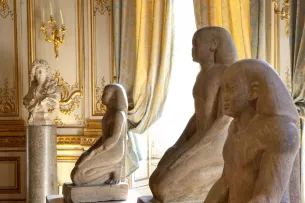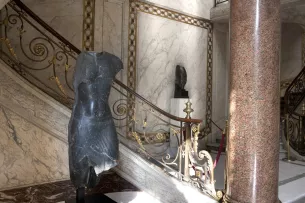ONLINE BOOKING STRONGLY RECOMMENDED. Due to the high number of visitors to the exhibition, access cannot be guaranteed for visitors without tickets.
Exposition
The Twilight of the Pharaohs
Masterpieces of the last Egyptian dynasties
From 23 March to 23 July 2012, the Jacquemart-André Museum will be displaying art from the last thousand years of the Pharaohs (1070-30 B.C.). This is the first exhibition to be devoted to the treasures of the last dynasties, during which various crises and invasions opened Egypt up to a range of influences. Over 100 exceptional artefacts, on loan from the largest Ancient Egypt collections in the world (including the Ägyptisches Museum in Berlin, the British Museum in London, the Musée du Louvre, the Metropolitan Museum of Art in New York, the Museum of Fine arts in Boston and the Kunsthistorisches Museum in Vienna), demonstrate the breadth and diversity of Egyptian art after the last Ramesses Pharaohs.
Discover the last millennium of the Pharaohs
Egypt was invaded on a number of occasions during the thousand years before it was conquered by the Romans in 30 BC. It was governed by a succession of rulers – Libyan kings (Twenty-Second dynasty), the “black Pharaohs” from Nubia (Twenty-Fifth dynasty) and Persians (starting with the Twenty-Seventh dynasty) - before the Greeks took over with the conquest of Alexander the Great in 332 BC.
From a military and political perspective, this was an unstable period, but Egyptian art, with its long tradition under the Pharaohs, maintained its prestigious position under new foreign rulers, who appropriated its codes with slight variations in style. Although this has long been thought of as a time of decline, it actually saw an outstanding artistic revival. The Saite Period (672-525 BC) was the high point of this thousand-year era, and is considered a genuine renaissance in Egyptian art. It was during this period, under the Twenty-Sixth dynasty, that Egypt regained its independence, before being invaded by the Persians who formed the Twenty-Seventh dynasty.
This was a time of economic prosperity marked by encounters with other cultures. It saw the construction of large monuments celebrating the greatness of Egyptian culture.
From the kingdom of the living to the kingdom of the dead
The exhibition is organised by theme, in order to highlight the multiple faces of Egyptian art across the last ten dynasties.
The Pharaohs
Pharaohs, key figures in Egyptian art, are displayed in the first room. Despite the political upheavals, each new dynasty was careful to consolidate its authority by associating itself with the great Pharaohs. This gallery evokes the various approaches to depicting the Pharaohs and brings together some historical figures from the last millennium of the Egyptian Pharaohs: Shoshenq I, Psamtik II, Apries, Amasis II, Nectanebo I, Ptolemy II, and more.
The world of the gods
Representations of the gods are included in the exhibition next to the Pharaohs, underlining the originality of the Egyptian pantheon. Numerous anthropomorphic and zoomorphic divinities including the famous Gayer-Anderson cat, a representation of the cat-goddess Bastet, on loan for the exhibition from the British Museum, surround Amun, Isis and Osiris.
The foreign powers that controlled Egypt during these ten centuries had a preference for zoomorphic gods and encouraged the development of certain artistic techniques. Gold work, in particular, experienced a period of significant development under the Libyan dynasties (Fragmentary statue of Amun, Libyan Period, New York, Metropolitan Museum).
The kingdom of the dead
Magnificent burial artefacts are testament to lavish tombs and the central place of the cult of the dead in art (Large death mask, private collection). Three exhibition rooms are dedicated to the offering tables, situlas, steles, jewels and ushabtis which decorated graves as well as hosting a full reconstruction of a tomb with all its burial furniture in the great tradition of earlier dynasties.
Egypt’s thousand faces
Statues gave prominence to the representation of the body, illustrated by the variety and precision of male and female figures. During this period they reach a hitherto unrivalled quality of representation: the poses of figures praying in temples become more diverse (Block statue of Pa-di-Chahdedet, Twenty-Sixth dynasty, Louvre collection at the Petit Palais, Paris), body shapes become more precise (“Dattari” statue, Thirtieth dynasty, Brooklyn Museum, New York), and faces take on individual traits, reaching an unbelievable realism as seen with the famous “Green head” on loan for the exhibition from the Berlin Museum. Faces are seen as important, whether portrayed realistically or idealised. The cultural diversity of this country that was continually swinging between being invaded and liberated shows us an Egypt of a thousand faces over this period.
L'équipe
The Curatorial Team
Mr Olivier Perdu, an Egyptologist connected to the Chair of Egyptology of the Collège de France.Specialist in the Late Period of Ancient Egypt, Olivier Perdu is the author of various studies that appear in specialist journals concerning its history, texts and monuments. His research into the field has led to him participating in several conferences and symposia, and collaborating in several pieces of collective work, including the recent Companion to Ancient Egypt (Blackwell, 2010), where he retraces the evolution of Egypt during the Late Period. After having taught his specialism at the École du Louvre from 1983 to 2000 and publishing the catalogue of the Egyptian collection at the Musée de Picardie in Amiens in 1994 with Elsa Rickal, he is currently completing the catalogue of private Late Period statues from the Egyptian department at the Louvre, the first volume of which currently being printed. In addition to being vice-president of the Société Française d’Égyptologie (French Society of Egyptology), he has managed the Revue d’Égyptologie since 2009, the first French journal in this field.
Nicolas Sainte Fare Garnot, an art historian specialising in seventeenth-century French painting, has been curator at the Jacquemart-André Museum since 1993. Since his appointment, he has reorganised the distribution of the collections according to the original programme and has initiated various restoration and inventory campaigns. Together with Culturespaces he has helped to create a new dynamic within the Museum by bringing his scientific approach to bear on temporary exhibitions whose subjects offer an opportunity to get to know the artists contained in the permanent collections.
Scenography
Hubert Le Gall, born in 1961, is a French designer, creator and sculptor of contemporary art. His work has formed the subject of numerous exhibitions throughout Europe. Since 2000 he has produced original scenographies for exhibitions.

